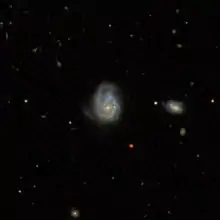NGC 3191
NGC 3191 (also known as NGC 3192) is a barred spiral galaxy in constellation Ursa Major. It is located at a distance of circa 400 million light years from Earth, which, given its apparent dimensions, means that NGC 3191 is about 115,000 light years across. The galaxy has been distorted and interacts with a companion 1.3 armin to the west. An extremely blue tidal bridge lies between them.[2]
| NGC 3191 | |
|---|---|
 SDSS image of NGC 3191 (center) | |
| Observation data (J2000 epoch) | |
| Constellation | Ursa Major |
| Right ascension | 10h 19m 05.1s[1] |
| Declination | 46° 27′ 15″[1] |
| Redshift | 9182 ± 4 km/s[1] |
| Distance | 411 Mly (126 Mpc)[1] |
| Apparent magnitude (V) | 13.2 |
| Characteristics | |
| Type | SB(s)bc pec [1] |
| Apparent size (V) | 0′.8 × 0′.6[1] |
| Other designations | |
| NGC 3192, UGC 5565, MCG +08-19-018, PGC 30136[1] | |
Two supernovae have been observed in NGC 3191, SN 1988B and SN 2017egm. SN 1988B was discovered by P. Wild 10" north of the galaxy's center. On Jan. 18.94 and 21.85 UT, it was at mag about 15.5.[3] It was a type Ia supernova.[4] SN 2017egm is identified as a Type I superluminous supernova. It is the closest supernova of this type observed and also the first to be found in a massive spiral galaxy. It was discovered by Gaia satellite on 23 May 2017.[5]
References
- "NASA/IPAC Extragalactic Database". Results for NGC 3191. Retrieved 2016-01-18.
- Takeuchi, Tsutomu T.; Tomita, Akihiko; Nakanishi, Kouichiro; Ishii, Takako T.; Iwata, Ikuru; Saito, Mamoru (April 1999). "Photometric Properties of Kiso Ultraviolet - Excess Galaxies in the Lynx - Ursa Major Region". The Astrophysical Journal Supplement Series. 121 (2): 445–472. arXiv:astro-ph/9810161. Bibcode:1999ApJS..121..445T. doi:10.1086/313203. S2CID 15506322.
- "IAUC 4533". Central Bureau for Astronomical Telegrams. Retrieved 29 June 2017.
- "IAUC 4535". Central Bureau for Astronomical Telegrams. Retrieved 29 June 2017.
- Bose, Subhash; Dong, Subo; Pastorello, A.; Filippenko, Alexei V.; Kochanek, C. S.; Mauerhan, Jon; et al. (2 August 2017). "Gaia17biu/SN 2017egm in NGC 3191: The closest hydrogen-poor superluminous supernova to date is in a "normal", massive, metal-rich spiral galaxy". The Astrophysical Journal. 853 (1): 57. arXiv:1708.00864. Bibcode:2018ApJ...853...57B. doi:10.3847/1538-4357/aaa298. ISSN 1538-4357. S2CID 54610579.
External links
 Media related to NGC 3191 at Wikimedia Commons
Media related to NGC 3191 at Wikimedia Commons
- NGC 3191 on WikiSky: DSS2, SDSS, GALEX, IRAS, Hydrogen α, X-Ray, Astrophoto, Sky Map, Articles and images